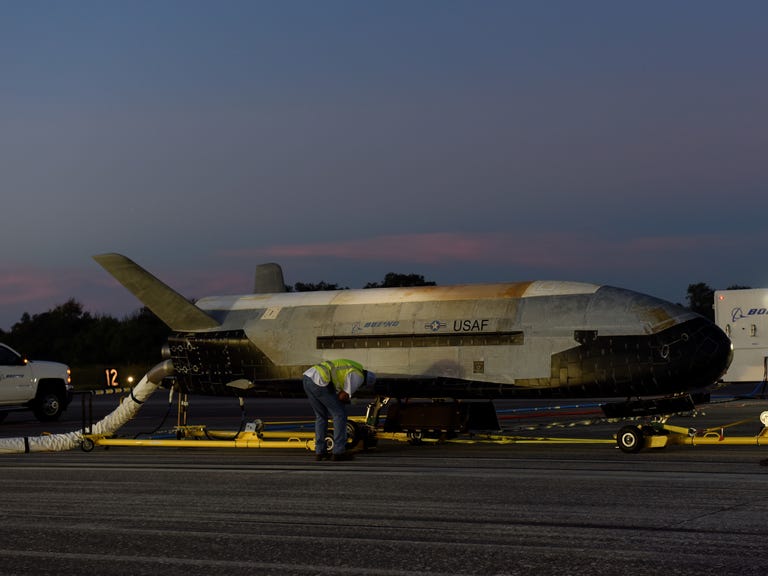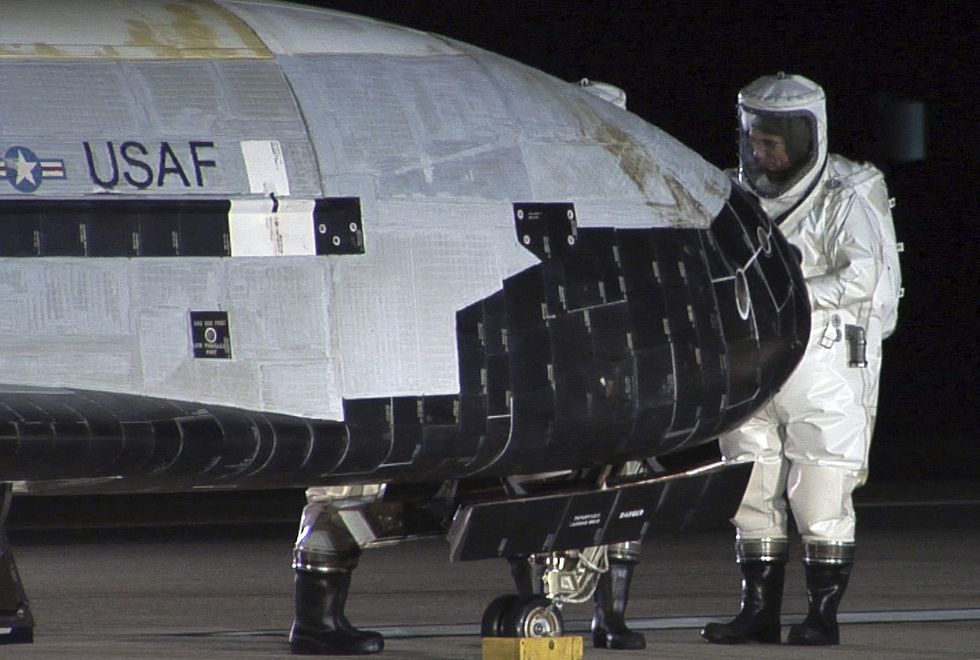KYLE MIZOKAMI

On December 28 at NASA’s Kennedy Space Center in Cape Canaveral, Florida, SpaceX’s Falcon Heavy rocket blasted the U.S. military’s X-37B spaceplane into orbit for its seventh unmanned mission, about two weeks behind schedule due to poor weather and technical issues. It’s not clear where the ultra-secretive spaceplane is headed, but we do know it’s conducting a wide range of research projects, including “operating the reusable spaceplane in new orbital regimes, experimenting with future space domain awareness technologies, and investigating the radiation effects on materials provided by NASA,” per a November press release from the U.S. Space Force.
Two weeks before this most recent X-37B launch, China’s own mysterious new spacecraft took a page from its American counterpart’s playbook, reportedly deploying six objects into low-Earth orbit from its payload bay, a mission the U.S. Air Force’s X-37B has been performing for more than a decade. Had the American launch occurred on schedule, the two vehicles would have entered space at about the same time—making the Chinese effort look like intentional competition.
One thing X-37B and the Divine Dragon have in common: both are excellent platforms for space-based experiments.
“It’s no surprise that the Chinese are extremely interested in our spaceplane. We’re extremely interested in theirs,” Space Force Gen. B Chance Saltzman told Air & Space Forces Magazine earlier this month. “These are two of the most watched objects on orbit while they’re on orbit. It’s probably no coincidence that they’re trying to match us in timing and sequence of this,” he said.
Still, comparing the two isn’t all that easy. Here’s what we know so far about how America’s X-37B stacks up against China’s Shenlong spaceplane.
“Divine Dragon”

A Long March 2F rocket blasting off into space. The Chinese government has yet to release photos of the Shenlong.
The Shenlong, or “Divine Dragon” spaceplane, rocketed into orbit on December 14 aboard a Long March 2F rocket from the Jiuquan Satellite Launch Center in the Gobi Desert. Constructed by the People’s Liberation Army in 1956, Jiuquan is the most military-oriented of China’s four space launch sites.
The Chinese government tried to keep this third launch low-key. Xinhua, China’s state media agency, barely even mentioned it, and tersely stated “the test spacecraft will operate in orbit for a period of time and then return to a scheduled landing site in China.”
The tabloid Global Times, which tends to tout China’s military accomplishments—but follows Chinese government censorship—made no mention of this third launch, but did cover the second. The Sina blogging platform covered it, but sourced from American and Singaporean media sources.
According to Space News, Shenlong has deployed six microsatellites, nicknamed A, B, C, D, E, and F. The purpose of these microsatellites is unknown, though all are apparently broadcasting a signal, likely to Chinese ground control stations.
X-37B vs Divine Dragon

The X-37B Orbital Test Vehicle in the encapsulation cell at the Astrotech facility in April 2010, in Titusville, Florida.
The Boeing-built X-37B is a reusable robotic spaceplane the U.S. Space Force operates. Lacking engines of its own, the X-37B is more properly a space glider, designed to be carried into space by either a United Launch Alliance Atlas V or a SpaceX Falcon Heavy space launch vehicle. After its mission is complete, the X-37B re-enters Earth’s atmosphere like its predecessor, the Space Shuttle, landing at the Kennedy Space Center Shuttle Landing Facility.
The diminutive spaceplane is similar to, but much smaller than, the original Space Shuttle. The X-37B is 29 feet long and 9.5 feet tall with a wingspan of 14 feet 11 inches. It has a payload bay measuring approximately 7 feet by 4 feet, covered by clamshell doors during launch. There are two X-37Bs.

Ground crews inspect the first X-37B after return from its maiden flight, 2010.
The X-37B first flew in 2010, staying aloft for 224 days. The lack of a human crew not only makes for a smaller spacecraft, but means the X-37B can remain in orbit as long as needed. The last mission, OTV-6, went on for a record 908 days. The current mission is known as OTV-7 (Orbital Test Vehicle-7), and while it’s unclear how long the spaceplane will remain in space, it’s likely to remain in orbit for over two years if history serves as any indication.
Meanwhile, very little is known about the Divine Dragon. China Aerospace Science and Technology Corporation (CASC), which also produces the Long March series of satellite launch vehicles, developed the spaceplane. China’s Shenlong has a similar concept of operation, riding into space on a Long March rocket and then gliding back to Earth.
Although there are several artists’ conceptions of what the spacecraft looks like floating around, the Chinese government has never released a photo of what it actually looks like at the time of this writing. And despite racking up multiple missions into space, no images of the spaceplane have been leaked to the public. According to Space News, an analysis of a recovered nose fairing suggests Divine Dragon has similar dimensions to the X-37B.
Both spacecraft also perform similar missions. The X-37B has deployed small satellites, and is also believed to be conducting experiments on subjects as varied as seeds, microwave power transmission between sources in space, and a ground receiver station. In 2015 it reportedly carried out experiments to investigate the viability of ion thrusters, a then-unproven space propulsion system.
What does the Divine Dragon do in space? While amateur space trackers can detect the deployment of microsatellites, the rest is a total mystery. Xinhua, in its brief statement covering the most recent Divine Dragon launch stated: “During this period, reusable technology verification and space science experiments will be carried out as planned to provide technical support for the peaceful use of space.”
One thing X-37B and the Divine Dragon have in common: both are excellent platforms for space-based experiments. Unlike regular satellites, the hardware both spaceplanes carry into space can be returned to Earth for analysis.

Both spaceplanes follow in the footsteps of the original spaceplane, the U.S. Space Shuttle.
Another thing the two spaceplanes have in common: both are unlikely to be armed. There is really no good reason to arm a spaceplane. While a spaceplane could theoretically carry weapons, particularly nuclear weapons, into orbit and deliver them quickly against a target below, it would be locked on an orbital path that most of the time would not be over a particular target. It would also be easily tracked by an adversary. A ground-based missile, on the other hand, could launch against any target on Earth and reach it within a matter of minutes.
The Takeaway
China and the United States have built similar spacecraft, likely for similar missions. There is nothing to suggest that either is a particular threat to the other country, though either could carry satellite payloads, like communications or spy satellites, that indirectly support military operations. X-37B and Divine Dragon are diminutive spaceplanes locked in a diminutive space race.
No comments:
Post a Comment